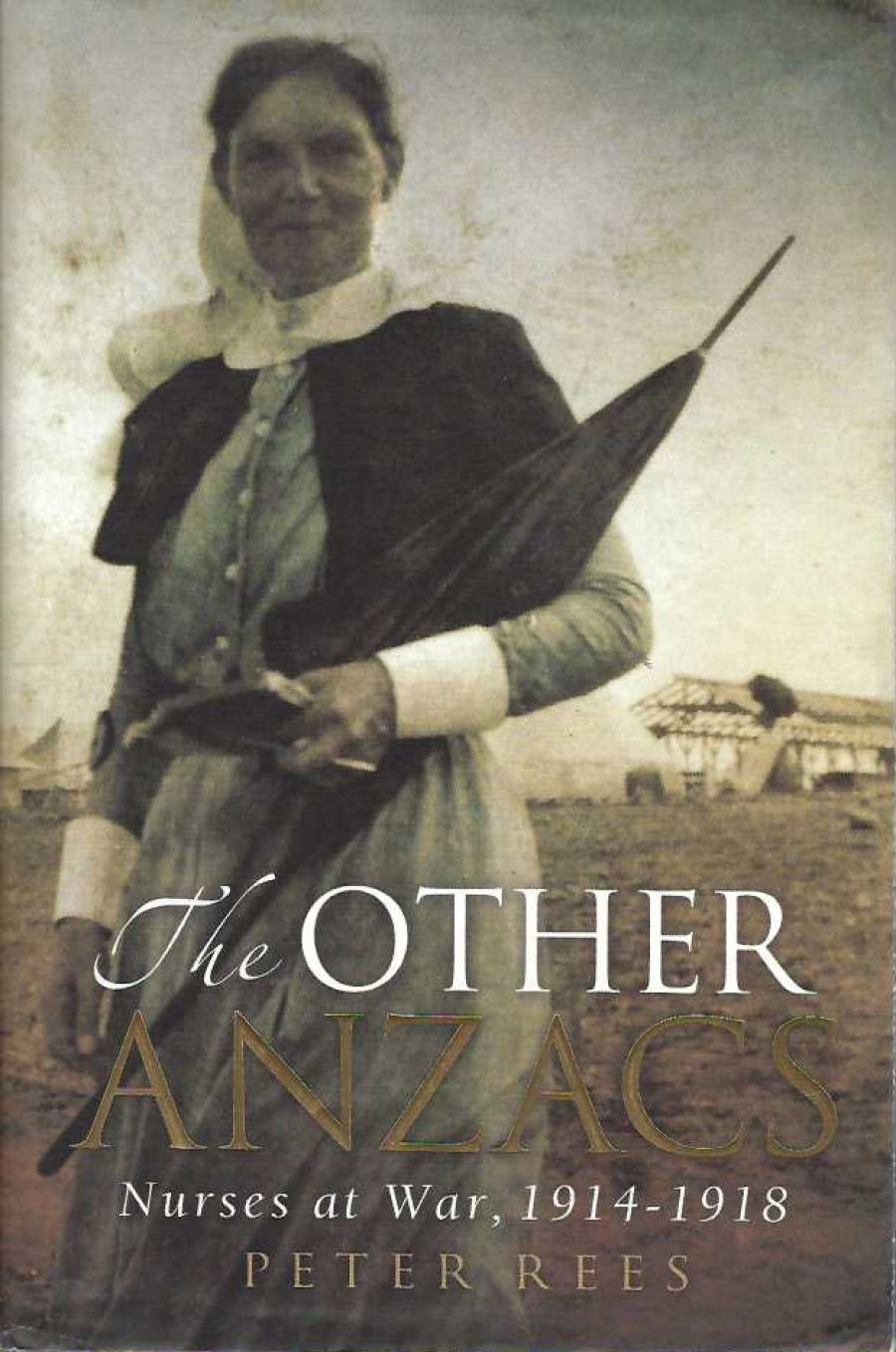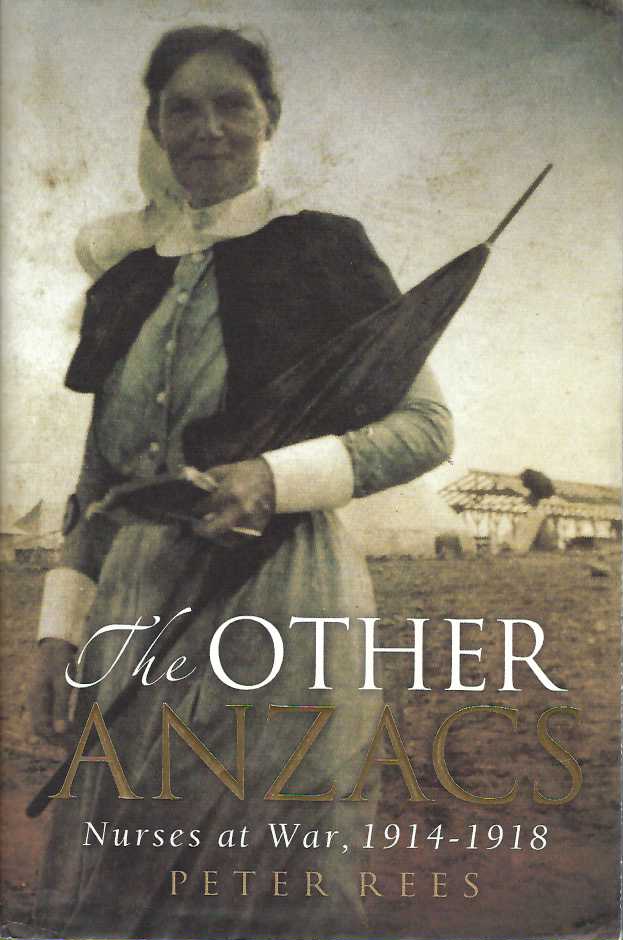
- Free Article: No
- Contents Category: History
- Review Article: Yes
- Article Title: Butchery and boyfriends
- Online Only: No
- Custom Highlight Text:
According to Peter Rees’s introduction to The Other Anzacs, ‘at least 2498 nurses’ served overseas with the Australian Army Nursing Service during World War I, with about 720 in other units raised in Britain or privately sponsored. There were ‘at least 610 nurses’ in the New Zealand Army Nursing Service, and perhaps another 100 overseas. The criteria for acceptance were high. Nurses were required to have completed at least three years’ training in an approved hospital, to be aged between twenty-one and forty, and either single or widowed. The rules about marriage, however, were not always strictly observed, and as men sometimes fudged their age and other circumstances to get into the army, occasionally a woman may have disguised her marital status. But once in the Army Nursing Service, marriage usually meant resignation. If a nurse wished to keep working after she married, she had to join one of the private medical or hospital services that had come into being.
- Book 1 Title: The Other Anzacs
- Book 1 Subtitle: Nurses at war, 1914–18
- Book 1 Biblio: Allen & Unwin, $49.95 hb, 363 pp
- Book 1 Cover Small (400 x 600):

- Book 1 Cover (800 x 1200):

Rees’s account views the war through letters and diaries written by nurses and some of their friends, mostly now in the Australian War Memorial. A handful have become major sources: for example, the diary of Elsie Cook. Elsie volunteered under her maiden name but six weeks later married Syd Cook, one of the nine children of Mary and Joseph Cook, who was prime minister of Australia in 1913, later deputy prime minister to Billy Hughes and, by the end of the war, Australian agent-general in London. The story of Elsie and Syd Cook is one of several romantic threads running through the book, though the possibility that official strings may have been pulled in their case raises questions not considered here.
The book falls into three sections. The first thirteen chapters, dominated by the Gallipoli campaign, and the last fifteen covering the gruelling years on the Western Front, are hinged by four chapters that detail the torpedoing in October 1915 of the Marquette, a transport ship carrying both ammunition and the equipment and personnel of a New Zealand military hospital, in the Aegean. Ten nurses were lost with the Marquette. Their names, along with seven other New Zealand and twenty-eight Australian nurses who died during the war, are listed in appendices.
In Egypt, waiting for deployment to the real war, there was time for tourism and light-hearted romance. The nearest that nurses actually came to Gallipoli was working on hospital ships moored offshore, out of reach of the guns. For months the ships ran a ferry service to hospitals in Egypt and on various islands in the Mediterranean where other nurses staffed them. After the withdrawal from Gallipoli, most nurses were deployed to Europe, but maps of both the eastern Mediterranean and of the Western Front are needed to follow the locations of the various hospitals and the movements between them.
On the Western Front, we follow the course of the war from one battle to the next, once more through quotations plucked from nurses’ letters or diaries. Despite the focus being on the women’s accounts, it is in fact an old-fashioned history of the war that has shaped this book. Though there were about 550 Australian nurses working in hospitals in India and in Mesopotamia during this time, while others continued in Egypt through to the end, the story as told is confined to the Western Front, with occasional periods of leave or work in hospitals in England.
It is not always easy to grasp who the ‘characters’ are. I would have appreciated more on the nurses themselves – their ages and prior training, and where they came from. Were they country girls, Australian-born, Protestant or Catholic? Biographical background is skimpy, and there is no attempt to analyse the social characteristics of the group as a whole. In the chapter on ‘Conscription’, ten voices are heard, every one of them fiercely in favour of conscription. Were these ten typical or representative? It is known that women in Australia were bitterly divided themselves over conscription and that the women’s vote was more in favour than against, but so were the votes of those born in Britain, primary producers and Protestants. Where did the nurses fit? This chapter explains nothing.
Given the reliance on diaries and letters. there is remarkably little about daily living conditions. The cold, the wet, the mud and the lack of heating are often mentioned, yet many of the photographs show individuals and groups of nurses in snowy starched veils, neat coats and hats, and some very smart-looking shoes, obviously not what they wore in the wards. How did they manage the washing and starching and ironing needed to tum out so smartly, if only for official photographs? It is said that they travelled light, yet one nurse carted around France a wind-up gramophone (and presumably records), as well as a primus stove.
According to the dust jacket, Peter FitzSimons, author of a recent popular history of the siege of Tobruk (2006), found this book ‘Absorbing ... wonderful ... inspiring’. I found it both depressing and disturbing. It was depressing because it was so grimly and gruesomely repetitive. Each battle seen through the eyes of the nurses was very much the same as the one before: the opening gun barrage followed by the ghastly procession of dying and wounded soldiers. The phrase ‘like a butcher shop’ tends to recur in their accounts. The main thing differentiating one battle from the next becomes the brother, boyfriend, or other significant male at risk. Underlying the whole account is nothing but pain, suffering, death, and the destruction of so many hundreds of thousands of young men. This is undoubtedly what it was like, but reiteration does not enlarge understanding.
What disturbed me, apart from an initial emphasis on frivolity, was the passivity, the helplessness, conveyed not only in the treatment the women received at the hands of the military Establishment, both during and after the war, but also in the author’s reluctance to ask questions about his sources and about these women; to try to think about who they were and what this really meant in their lives. From other sources we know that there were matrons, women who stood up to the Establishment, but as the story is told here, there is little sense of women’s organisation, leadership, or achievement. Matron Grace Wilson, whose photograph appears on the cover, is said, several times, to have been outstanding, but she receives barely a dozen lines scattered through the text. Other senior women are more quickly dismissed – perhaps they left no diaries.
Yet just as the war enabled men with qualities of leadership to rise to prominence after it was over, for many of the nurses their war service was critical in their future careers, while the experiences of the war had a profound impact on nursing as a profession. But the short chapter titled ‘The Aftermath’ tells us only what happened to some of the leading ‘characters’, mostly whether or not they married, and when they died. Once more, it seems, the other Anzacs have been short-changed.


Comments powered by CComment